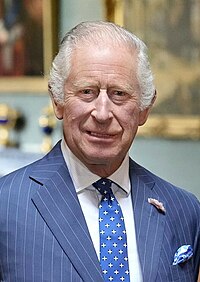
Back Monargie van die Verenigde Koninkryk AF الملكية في المملكة المتحدة Arabic Corona británica AST Böyük Britaniya monarxı AZ Монархия на Обединеното кралство Bulgarian যুক্তরাজ্যের রাজতন্ত্র Bengali/Bangla Britská monarchie Czech Monarki (Storbritannien) Danish Britische Monarchie German Μοναρχία του Ηνωμένου Βασιλείου Greek
| King of the United Kingdom | |
|---|---|
 | |
| Incumbent | |
 | |
| Charles III since 8 September 2022 | |
| Details | |
| Style | His Majesty |
| Heir apparent | William, Prince of Wales |
| Residence | See list |
| Website | royal |
The monarchy of the United Kingdom, commonly referred to as the British monarchy, is the constitutional form of government by which a hereditary sovereign reigns as the head of state of the United Kingdom, the Crown Dependencies and the British Overseas Territories. The current monarch is King Charles III, who ascended the throne on 8 September 2022, upon the death of his mother, Queen Elizabeth II.
The monarch and their immediate family undertake various official, ceremonial, diplomatic and representational duties. Although formally the monarch has authority over the government—which is known as "His/Her Majesty's Government"—this power may only be used according to laws enacted in Parliament and within constraints of convention and precedent. In practice the monarch's role, including that of Head of the British Armed Forces, is limited to functions such as bestowing honours and appointing the prime minister, which are performed in a non-partisan manner.[2] The UK Government has called the monarchy "a unique soft power and diplomatic asset".[3] The Crown also occupies a unique cultural role, serving as an unofficial brand ambassador for British interests and values abroad, increasing tourism at home, and promoting charities throughout civil society.[4][5]
The British monarchy traces its origins from the petty kingdoms of Anglo-Saxon England and early medieval Scotland, which consolidated into the kingdoms of England and Scotland by the 10th century. England was conquered by the Normans in 1066, after which Wales also gradually came under the control of Anglo-Normans. The process was completed in the 13th century when the Principality of Wales became a client state of the English kingdom. The Anglo-Normans also established the Lordship of Ireland. Meanwhile, Magna Carta began the process of reducing the English monarch's political powers. In the 16th century, English and Scottish monarchs played a central role in what became the religious English Reformation and Scottish Reformation, and the English king became King of Ireland. Beginning in 1603, the English and Scottish kingdoms were ruled by a single sovereign. From 1649 to 1660, the tradition of monarchy was broken by the republican Commonwealth of England, which followed the Wars of the Three Kingdoms. Following the installation of William III and Mary II as co-monarchs in the Glorious Revolution, the Bill of Rights 1689, and its Scottish counterpart the Claim of Right Act 1689, further curtailed the power of the monarchy and excluded Roman Catholics from succession to the throne. In 1707, the kingdoms of England and Scotland were merged to create the Kingdom of Great Britain, and in 1801, the Kingdom of Ireland joined to create the United Kingdom of Great Britain and Ireland.
Beginning in the 16th century, the monarch was the nominal head of what came to be the vast British Empire, which covered a quarter of the world's land area at its greatest extent in 1921. The title Emperor of India was added to the British monarch's titles between 1876 and 1948. The Balfour Declaration of 1926 recognised the evolution of the Dominions of the Empire into separate, self-governing countries within a Commonwealth of Nations. Also in this period, the monarchy in Ireland eventually became limited to Northern Ireland. In the years after the Second World War, the vast majority of British colonies and territories became independent, effectively bringing the Empire to an end. George VI and his successors adopted the title Head of the Commonwealth as a symbol of the free association of its independent member states. The United Kingdom and fourteen other independent sovereign states that share the same person as their monarch are called Commonwealth realms. Although the monarch is shared, each country is sovereign and independent of the others, and the monarch has a different, specific, and official national title and style for each realm. Although the term is rarely used today, the fifteen Commonwealth realms are, with respect to their monarch, in personal union.
- ^ Pegg, David; Evans, Rob (7 February 2021). "Revealed: Queen lobbied for change in law to hide her private wealth". The Guardian. Retrieved 11 September 2022.
- ^ The sovereign is, however, entitled to comment on drafts of laws that would directly affect the monarchy [1]
- ^ Select Committee on Soft Power and the UK's Influence, House of Lords (14 March 2014). Persuasion and Power in the Modern World (Report). HL Paper 150.
- ^ Hay, George (9 September 2022). "Queen was Britain's ultimate brand ambassador". Reuters. Retrieved 4 April 2023.
- ^ "Charities and Patronages". The Royal Family. Retrieved 4 April 2023.